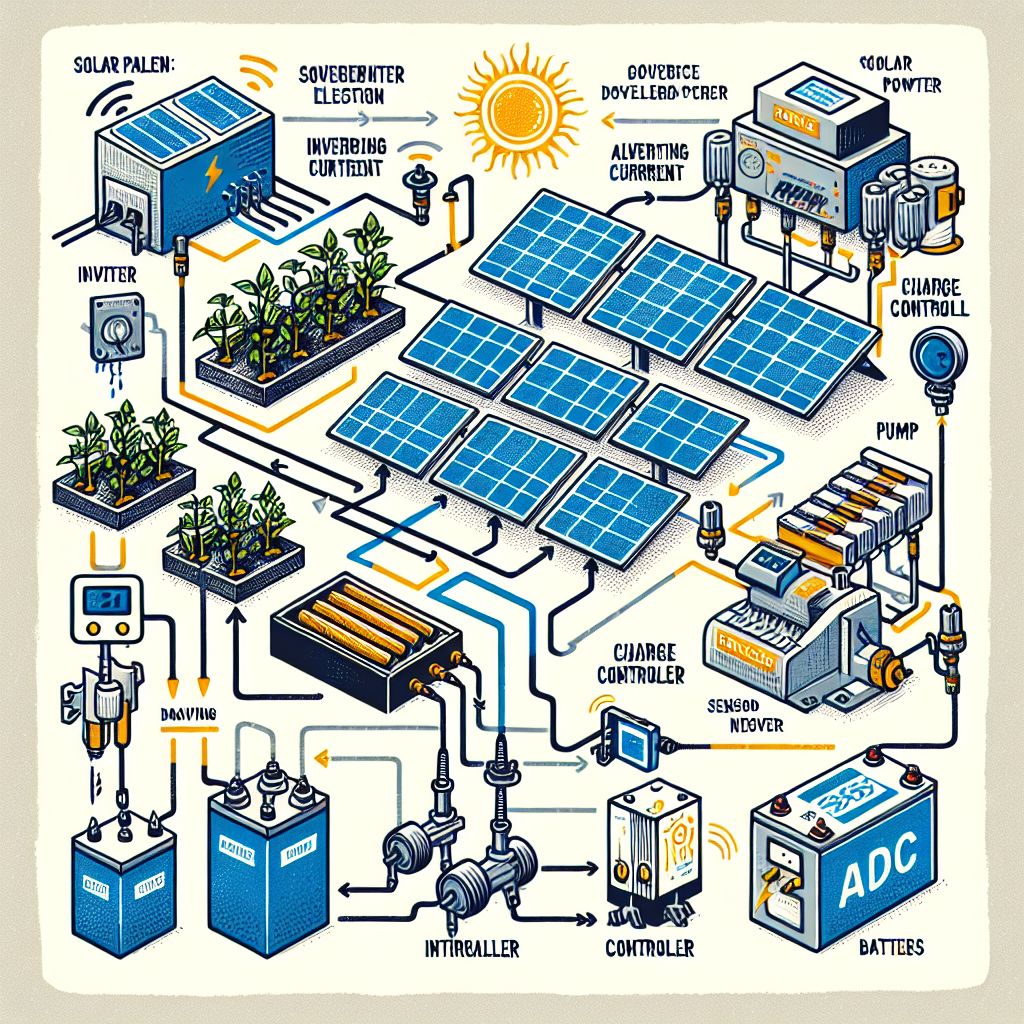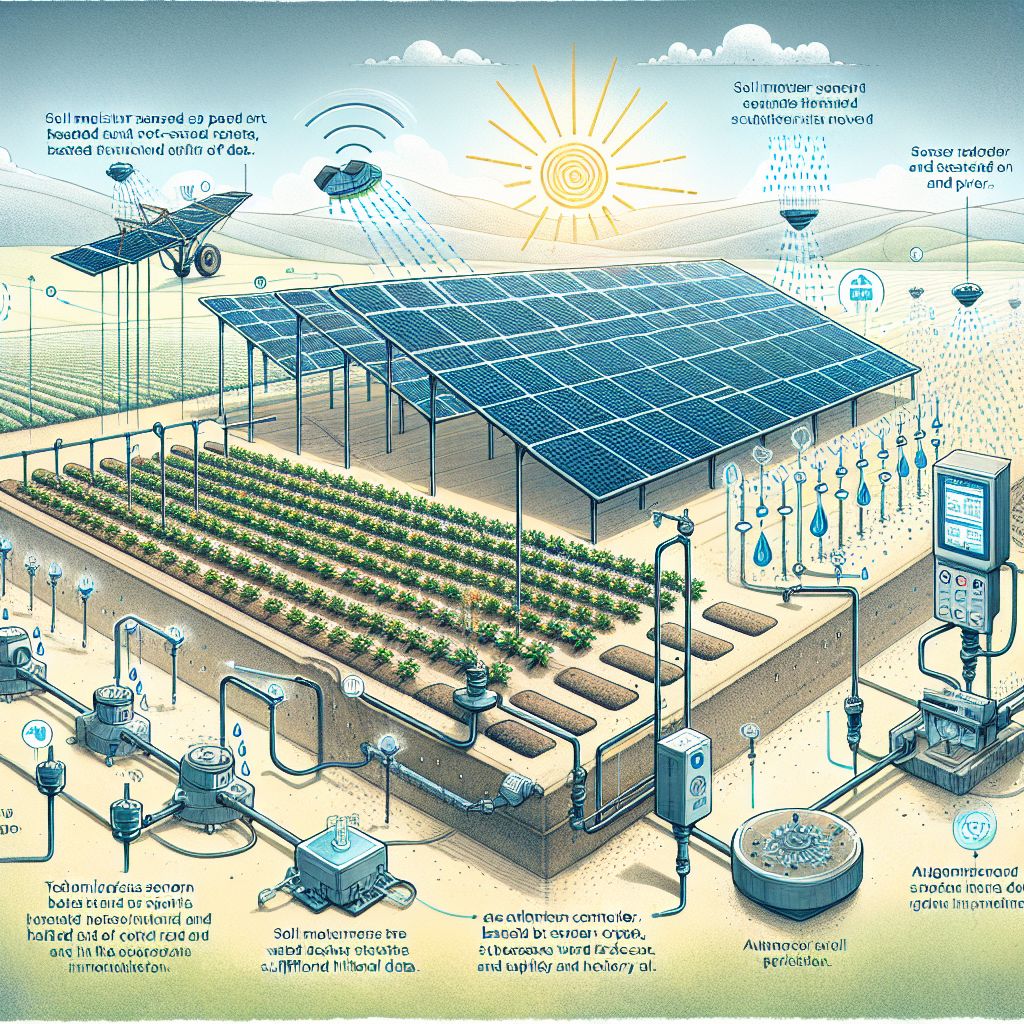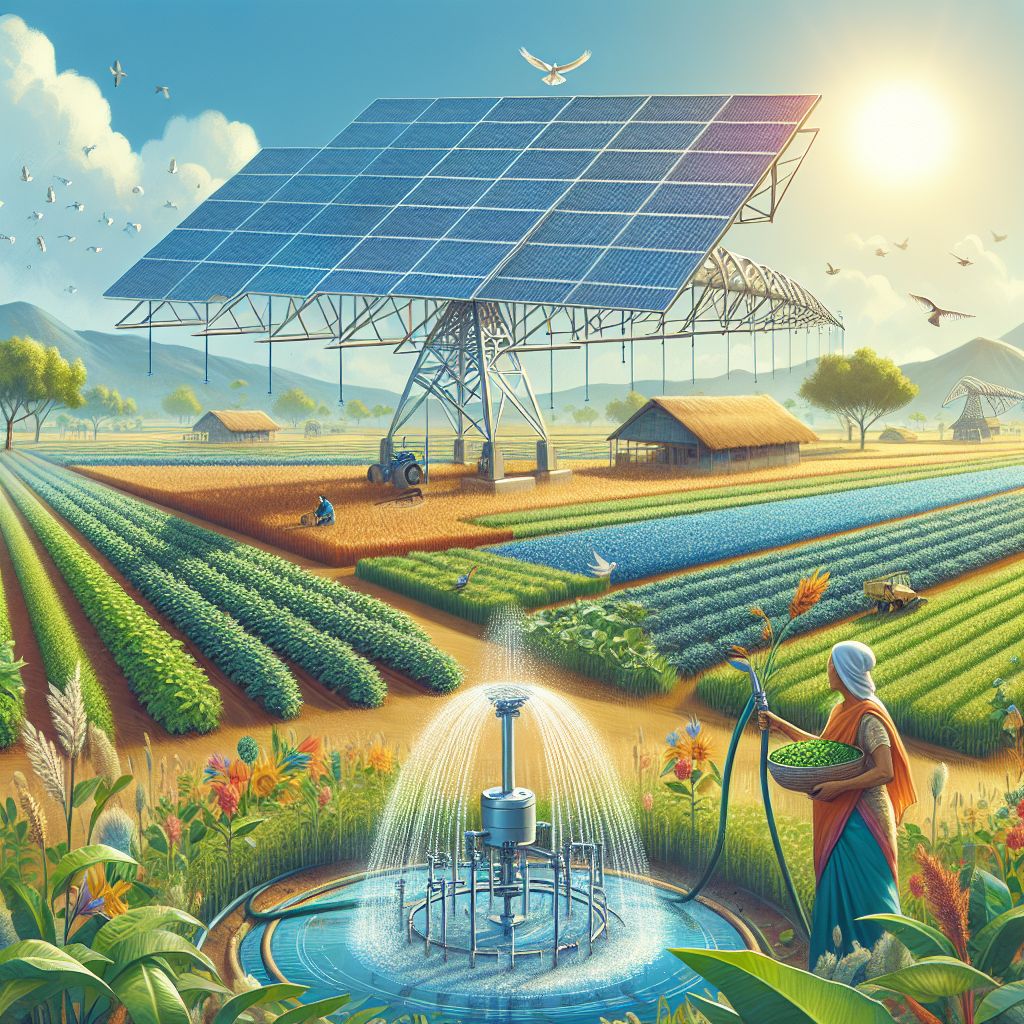
Key Takeaways
-
Solar irrigation systems harness sunlight to power water pumps, reducing reliance on non-renewable energy sources.
-
Integrating IoT sensors with solar irrigation leads to precision farming, conserving water and enhancing crop yields.
-
Understanding the components of a solar irrigation system is crucial for proper implementation and maximization of benefits.
-
Adopting solar irrigation can lead to significant cost savings and promote sustainable agricultural practices.
-
Questions like system lifespan, functionality during cloudy days, and maintenance requirements are vital for farmers considering solar irrigation.
Harvesting the Sun: How Solar Power Is Revolutionizing Irrigation
Imagine a farm where the fields are watered by the power of the sun. This isn’t a vision of the future; it’s happening right now with solar irrigation systems. These systems are not just a nod to sustainability; they’re a smart, cost-effective solution that’s transforming the way we farm.
Basics of Solar Irrigation Technology
At the heart of solar irrigation is the simple yet powerful concept of using the sun’s energy to pump water. This is done through solar panels, which convert sunlight into electricity. This electricity then powers a pump that draws water from a source—be it a well, a pond, or a river—and delivers it to the crops. It’s clean energy meeting one of the most critical needs of farming: irrigation.
But why is this so revolutionary? Because it offers a way to irrigate crops without relying on the electrical grid or diesel generators. For farmers in remote areas or regions with unreliable power, solar irrigation can be a game-changer.
Impact on Water Conservation
One of the most pressing issues in agriculture today is water conservation. Solar irrigation systems can be fine-tuned to provide water exactly when and where it’s needed, minimizing waste. This precision is made possible by IoT, or the Internet of Things, which allows devices to communicate with each other. Sensors placed in the soil can measure moisture levels and signal the solar-powered pump to turn on or off as needed.
This technology is not just about saving water; it’s about optimizing crop health. Crops get the right amount of water at the right time, which can lead to better yields and quality. And let’s not forget, conserving water also means conserving energy, as less pumping is required.

Understanding Solar Irrigation Systems
A solar irrigation system might sound complex, but it’s based on straightforward principles. The sun shines on the solar panels, creating electricity. This electricity is then used to power a pump. It’s a clean, self-sustaining cycle that harnesses one of nature’s most abundant resources: sunlight.
But to make the most of this technology, you need to understand its components. Let’s break it down:
The solar panel, often made from silicon, absorbs sunlight and generates direct current (DC) electricity. An inverter then converts this DC electricity into alternating current (AC), which can power irrigation pumps.
The pump itself is the workhorse of the system, moving water from the source to the crops. The size and type of pump will depend on the specific needs of the farm, such as the water source’s depth and the distance to the fields.
Solar Panels and the Photovoltaic Process
Solar panels are the stars of the show in solar irrigation systems. They use the photovoltaic process to convert sunlight into electricity. When sunlight hits the panels, it excites electrons in the silicon cells, creating an electric current. This current is then harnessed to power the irrigation pump.
The efficiency of these panels has improved dramatically over the years, meaning they can generate more power even on days with less than perfect sunlight. But it’s not just about efficiency; it’s also about durability. Solar panels are built to withstand the elements, ensuring they can provide a reliable source of power for years to come.
From Sun to Pump: Electrical Components Demystified
So, we’ve got the solar panels generating electricity, but that’s not the end of the story. There are other key components in a solar irrigation system that make sure the power gets to the pump safely and efficiently.
First up, the charge controller. This device ensures that the batteries, which store the solar energy, are charged correctly. It protects the batteries from being overcharged during sunny periods and from being drained too low when the pump is in use.
Then there’s the inverter. While some irrigation pumps can run on DC power, many require AC power—the same kind you get from the electrical grid. The inverter takes the DC power from the solar panels or batteries and converts it into AC power for the pump.
Finally, the batteries themselves. They store the solar energy, making it possible for the irrigation system to work even when the sun isn’t shining. This means the pump can run during the night or on cloudy days, ensuring a consistent water supply to the crops.
Now, let’s get our hands dirty and delve into the nitty-gritty of what makes a solar irrigation system not just work, but excel. It’s all about the sensors and the controllers—these are the brains of the operation.

Watering with Precision: The Role of Sensors and Controllers
The use of sensors and controllers in a solar irrigation system has revolutionized the way farmers irrigate their crops. This technology ensures that crops receive the right amount of water at the right time, conserving water resources, and improving crop production. With the increasing demand for food production globally, the adoption of solar irrigation systems with precision technology is crucial for sustainable farming practices. As we continue to face challenges such as water scarcity and climate change, innovative solutions like this will play a vital role in the future of agriculture.
Soil Moisture Sensors: The Roots of Smart Irrigation
Imagine having a farmhand who’s always in the field, constantly checking the soil. That’s what soil moisture sensors do. They’re placed at the root level of your crops and measure how much water is in the soil. If the soil is too dry, the sensors send a signal to the irrigation system to start pumping water. Too wet, and they tell it to hold off. This means you’re not just saving water; you’re giving your crops exactly what they need, when they need it.
Automated Controllers: Scheduling Irrigation Intelligently
With automated controllers, you’re not just guessing when to water your crops; you’re making data-driven decisions. These controllers use information from the soil moisture sensors, weather forecasts, and even historical data to determine the best irrigation schedule. They can turn the pumps on and off at just the right times, ensuring efficient water use and reducing the burden on the farmer.
Here is a table outlining the roles of sensors and controllers used in a Solar Irrigation System on a farm based on the provided sources:
| Component | Description |
| Solar Sensor | Measures the intensity of sunlight to determine when to trigger irrigation based on light levels. 1, 3, 4 |
| Moisture Sensor | Measures the soil moisture content to optimize irrigation and prevent over/under watering. 3, 4 |
| Solar Integrator Controller | Integrates the solar sensor data to automatically start and stop irrigation based on light levels, overriding timed schedules. 1 |
| Irrigation Controller | Controls the timing and duration of irrigation cycles, with the ability to be solar-activated by the integrator. 1, 2, 3, 4 |
| Anti-Siphon Valve | Prevents backflow and contamination of the water supply during irrigation. 2 |
This table summarizes the key sensors and controllers used in a Solar Irrigation System on a farm, highlighting their roles in optimizing water usage and enhancing crop yield.

Economic and Environmental Outcomes of Solar Irrigation
It’s clear that solar irrigation is good for the planet, but it’s also good for your pocket. By cutting out the costs of fuel or grid electricity to run pumps, you’re looking at some serious savings. Plus, with precision irrigation, you’re using less water, which can mean lower water bills or less strain on your water source.
This below table summarizes the key economic and environmental outcomes of using a solar-powered irrigation system on a farm.
| Economic Outcomes | |
| Reduced Fuel Costs | Farmers can eliminate the need for expensive and polluting diesel fuel to power irrigation pumps. 1, 3, 4 |
| Increased Crop Yields | Solar irrigation allows farmers to grow more water-intensive cash crops and expand their businesses. 3, 4 |
| Improved Household Spending | Farmers have increased purchasing power to invest in household well-being. 2 |
| Foreign Currency Savings | Use of solar irrigation can reduce the need to import fossil fuels, saving foreign currency. 2 |
| Environmental Outcomes | |
| Reduced CO2 Emissions | Solar-powered irrigation has zero direct CO2 emissions, unlike diesel-powered systems. 2, 3 |
| Groundwater Depletion Concerns | Increased access to affordable solar irrigation can lead to over-extraction of groundwater resources. 3, 4 |
| Need for Sustainable Groundwater Management | Policies and community-based approaches are needed to manage groundwater use sustainably. 4 |
Reduced Operational Costs for Farmers
By harnessing the power of the sun, farmers can drastically cut their energy costs. The sun doesn’t send a bill, so once you’ve covered the initial setup costs, the energy for your irrigation is essentially free. And because these systems are low maintenance, the ongoing costs are minimal as well.
Boosting Sustainable Agriculture Practices
But the benefits go beyond economics. Solar irrigation supports sustainable agriculture by reducing the carbon footprint associated with traditional irrigation methods. This means you’re not just growing crops; you’re helping grow a healthier planet.
And there’s more. Sustainable practices like solar irrigation can qualify you for various grants, subsidies, or certifications, which can improve your market standing. Consumers are increasingly looking for sustainably grown produce, so by adopting solar irrigation, you’re tapping into a growing market.

Steps to Implement Your Solar Irrigation System
Ready to take the plunge into solar irrigation? Here’s a step-by-step guide to get you started:
-
Assess your water needs: How much water do your crops need, and when do they need it?
-
Choose the right system size: This depends on the size of your farm and the amount of sunlight you get.
-
Find a reputable supplier: Look for companies with experience in solar irrigation systems.
-
Install your system: This might be a DIY job for smaller setups, or you might need professional help for larger farms.
-
Monitor and maintain: Keep an eye on your system to make sure it’s working efficiently and make adjustments as needed.
Example: Jane, a farmer in California, installed a solar irrigation system for her vineyard. She saw a 30% reduction in water usage and a 20% increase in crop yield within the first year. Her success story is a testament to the effectiveness of solar irrigation.
Remember, the key to a successful solar irrigation system is planning. You need to understand your farm’s unique needs and choose a system that’s right for you.
Assessing Your Irrigation Needs
Start by figuring out how much water your crops need. This isn’t a guessing game; it’s about understanding your soil, your climate, and your crops. Once you’ve got that down, you’ll know how powerful your solar pump needs to be and how many solar panels you’ll need to run it.
Choosing the Right Solar Irrigation Kit
There’s no one-size-fits-all solution here. You need to choose a solar irrigation kit that matches your needs. Consider factors like the size of your farm, the types of crops you’re growing, and your local climate. The right kit will be efficient, cost-effective, and durable enough to handle your farming conditions.
Frequently Asked Questions
When it comes to solar irrigation systems, there are always a few questions that pop up regularly. Let’s clear the air on some of these common queries:
What is the Lifespan of a Solar Irrigation System?
The panels themselves can last up to 25 years or more, which is quite a stretch. The pump and other equipment have shorter lifespans, but with proper care, you’re looking at a solid 10 to 15 years of operation. Remember, the better you maintain your solar irrigation system, the longer it will last.
Can Solar Irrigation Systems Work on Cloudy Days?
Yes, they can. Modern solar panels are designed to capture diffused sunlight, which is present even on cloudy days. The efficiency might drop a bit, but if you’ve got a battery backup, you won’t even notice the difference. The system stores excess energy on sunny days, which comes in handy when the clouds roll in.
Moreover, solar panels have improved in efficiency over the years and now can generate significant power even with limited sunlight. Plus, a well-designed system takes into account the local weather patterns to ensure a steady water supply.
How Much Water Can Solar Irrigation Save Annually?
It’s all about precision. By watering only when and where it’s needed, you can save anywhere from 20% to 50% of the water that would otherwise be used with traditional irrigation. This can translate to thousands of gallons saved each year, depending on the size of your operation.
For example, if a traditional system uses 100,000 gallons a year, a well-configured solar irrigation system might only use 50,000 to 80,000 gallons. That’s a significant saving, both for the environment and your water bill.
Is Solar Irrigation Suitable for All Types of Crops?
Mostly, yes. Whether you’re growing leafy greens or managing an orchard, solar irrigation can be tailored to fit. The trick is in the setup—adjusting the flow rates, the timing, and the distribution to meet the specific needs of your crops.
For instance, drip irrigation can be used for row crops, while a more spread-out spray might be better for an orchard. The flexibility of solar irrigation systems means they can be adapted for almost any type of farming.
What Are the Maintenance Requirements for Solar Irrigation Systems?
Maintenance is pretty straightforward. Keep the panels clean, check the connections, and make sure the pump is in good working order. Most systems come with monitoring software that alerts you to any potential issues, making it easier to keep things running smoothly.
Regularly cleaning the solar panels is essential; dust and debris can reduce their efficiency. For the pump and other hardware, follow the manufacturer’s guidelines for maintenance to ensure optimal performance and longevity.
Conclusion:
In the world of agriculture, solar irrigation systems are a bright spot, offering a sustainable and cost-effective way to water crops. They’re a testament to the power of innovation and the benefits of embracing renewable energy.
By understanding the components and benefits of solar irrigation, farmers can make informed decisions that not only save water and reduce energy costs but also contribute to a healthier planet. It’s a win-win situation where the environment benefits as much as the bottom line.






